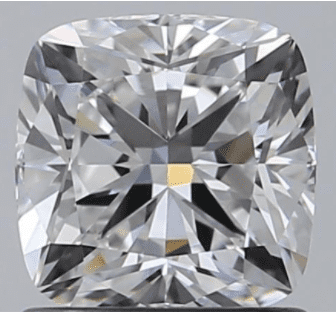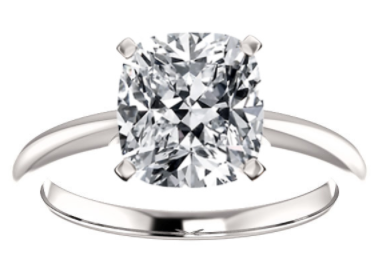Round Cut vs. Cushion Cut Diamonds Which is Better or Bigger?
- Round cut offers maximum sparkle and timeless appeal.
- Cushion cut is soft, romantic, and slightly more vintage-looking.
- Round cuts are pricier due to higher demand and rough wastage.
- Cushion cuts offer a larger face-up size for less cost.
- Personal taste and setting style often guide the final choice.
At Rare Carat, we understand how your eyes can cross when picking out the perfect diamond. To the average person, they all might look relatively similar. We’re here to point out the nuances, so you can find the diamond of your dreams. Round Cut and Cushion Cut diamonds are the most beloved of all the stone shapes. Their timelessness speaks to a classic style, which makes them the quintessential cut for engagement rings. While aesthetics is one of the most important factors in selecting a stone, there are a few different factors that will have a major impact on style, sparkle, and price.
The Round
The Round cut tends to be more popular due to its setting versatility and high brilliance factor. Viewed from above, it looks like a perfect circle and is flattering on all finger types. Its distinctive dazzle comes from 57–58 perfectly placed facets. When light enters a diamond, it reflects and refracts inside before being emitted. This is what gives a diamond its sparkle. The shine created by a diamond is known as scintillation. The scintillation of a diamond is made up of two types of light: white light (called brilliance) and rainbow light (called fire). Overall, round-cut diamonds have more brilliance.
The Cushion
Cushion-cut diamonds are also named for their shape. From above, they look like a pillow or a “cushion.” This cut is emulative of an antique diamond shape called the old mine cut. Old mine cuts were originally designed to reflect under candlelight, which has given the modern cushion cut its romantic appeal. Although the number of facets varies on each cushion-cut diamond, they typically produce more fire because of facet placements.
Remember, there's no such thing as a "better" style regarding round and cushion-cut diamonds. It all comes down to personal preference when choosing the right diamond for you. If you're looking for something ultra-classic, the round diamond is a great option. Want something with a more romantic vintage appeal? Go for a cushion-cut diamond.
Choosing Size:
Some diamonds have a higher table surface area (the area on the top of the diamond) due to their shape. This is why some stones can look different sizes, even if they hold the same carat weight. Most fancy-shaped diamonds look larger than round diamonds, but cushion vs. round can vary. Because round diamonds have more brilliance, our eyes tend to interpret more light as a bigger size. On the other hand, cushion-cut diamonds have a slightly bigger table (top) per carat, as well as larger facets, which can make them appear larger than round cuts. Ultimately, cushion-cut and round diamonds of the same carat weight tend to look similar in size.
If you want your stone to look as large as possible without going up in carat size, look for a diamond with a higher cut grade. Choose a cut grade of Excellent for a natural round and Ideal for a lab grown round. Cushions don't get an official cut grade, but look for Very Good - Excellent polish and symmetry as well as ideal proportions (find those HERE or talk with a gemologist) for a well cut stone.
Selection:
The Four C’s will always be your guide when shopping for any type of diamond, but cushion cuts require additional attention.
To avoid an off-shape, look for symmetry in the stone's body — the sides and corners should match each other in the amount of bend. Technically, a perfectly square, cushion-cut diamond will have a ratio of 1.00, but anything up to 1.05 will look square to the eye. The ratio of your diamond is all personal preference, but it’s good to understand that not all cushion cuts are created equal.
Another thing to note while shopping for a cushion-cut diamond is keeping an eye out for depth and table percentage. This is where the magic or “sparkle” happens. Choosing a cushion-cut diamond with a depth percentage of 61% - 68% and a table percentage of 55% - 65% will keep it light and bright. Anything outside those numbers will make your diamond look dull.
Although a standard round brilliant has between 57–58 facets, facet patterns vary for cushion cuts. A “brilliant crushed ice” look will have double rows of facets, while 58 facets give your stone a more “chunky antique” look. Check out this article for a more in-depth look at the different types of cushion-cut diamonds.

Round-cut diamonds are pretty straightforward in buying approach and you really only need to pay attention to the Four C’s plus fluorescence. After comparing both shapes, you can buy engagement rings online on Rare Carat to see real examples side by side.
Price:
Round, brilliant-cut diamonds are the most expensive diamond shape because more rough crystal is cut off to make the perfect circle shape. They are also in high demand, which drives up the price. If two cushion-cut and round diamonds have the same carat weight and characteristics, you can expect the cushion-cut diamond to cost between 25% and 50% less.
Cushion-cut diamonds may be more affordable, but they require a little more attention when shopping for quality. At the end of the day, the most important thing to remember about buying your diamond is how much you love it. There truly is no right or wrong answer! If you value price-point but are in love with the look of the round-cut, you’ll never be satisfied with a cushion. If you already love the look of the cushion cut, then the price is just a bonus.
While buying a diamond is an investment, it’s also something to cherish for a lifetime. Follow your heart and get the diamond shape of your dreams, you will be happy you did.





